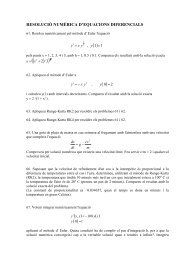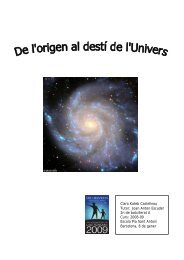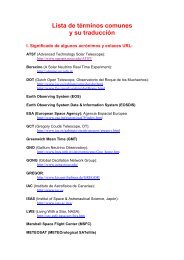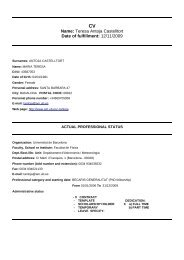Universitat de - Departament d'Astronomia i Meteorologia ...
Universitat de - Departament d'Astronomia i Meteorologia ...
Universitat de - Departament d'Astronomia i Meteorologia ...
You also want an ePaper? Increase the reach of your titles
YUMPU automatically turns print PDFs into web optimized ePapers that Google loves.
6.2. Observations and data reduction 153<br />
cient to reliably image the weakest radio sources. We improved that by first imaging<br />
in difmap the calibrator sources J0007+5706, J0147+5840, and J0630+1738, with<br />
appropriate amplitu<strong>de</strong> self-calibration. We <strong>de</strong>duced correction factors for each an-<br />
tenna, these being consistent for the three radio sources within 2%. The factors<br />
were: EB:0.98, JB:1.10, CM:0.78, WB:1.18, MC:0.87, NT:1.12, SH:1.03, TR:0.98<br />
and ON:0.97. We corrected the amplitu<strong>de</strong> calibration back in aips using the task<br />
sncor (optype ’mula’) for all the radio sources and exported the data again into<br />
difmap, where the final imaging was performed after editing and averaging of the<br />
visibilities in 32 s blocks.<br />
6.2.3 Combining EVN and MERLIN<br />
The EVN and MERLIN arrays have one common baseline, between JB and CM,<br />
which allows to combine both data sets and map them together. Combining data<br />
sets from both arrays allows us to reach (u, v) resolution ranges from 0.04 Mλ (MK2-<br />
Tabley) to 140 Mλ (NT-SH) at 5 GHz. We processed the data within aips in or<strong>de</strong>r<br />
to combine both arrays. The B1950.0 (u, v) coordinates of the MERLIN data had<br />
to be corrected to the ones of the EVN for the same reference system (J2000.0)<br />
with uvfix. Then, the MERLIN data were self-calibrated with the EVN images<br />
(see below), and the phase solutions were limited to the longest MERLIN baselines.<br />
The MERLIN data were imaged and the peak-of-brightness of both data sets were<br />
checked to be similar. As a next step, the EVN data were averaged in frequency<br />
to correspond to the MERLIN data. The aips hea<strong>de</strong>rs of both data sets were<br />
modified conveniently to match together, and the weighting of both data sets was<br />
also modified to be equal with wtmod. Finally, both data sets were concatenated<br />
(using dbcon) and exported to difmap to be imaged with different data weighting<br />
in (u, v) distance (tapering) after time averaging in 32 s bins.<br />
6.2.4 Flux <strong>de</strong>nsity measurements at the 100 m antenna in<br />
Effelsberg<br />
To complement the amplitu<strong>de</strong> calibration and obtain additional information on the<br />
radio sources, we interleaved cross-scans (in azimuth and elevation) with the 100 m<br />
Effelsberg antenna to measure the radio source flux <strong>de</strong>nsities (A. Kraus, private






